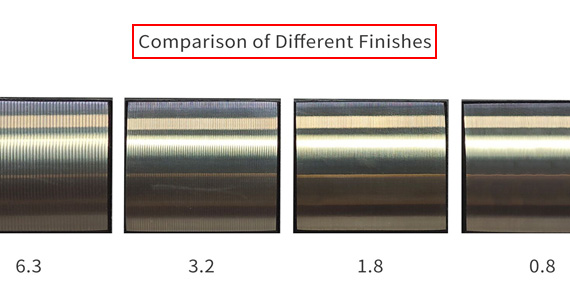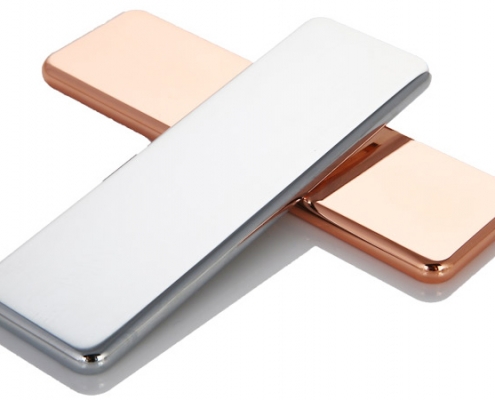Surface Roughness and Surface Finish Guide: Everything You Need to Know
Surface roughness and surface finish are important indicators for measuring the surface quality of parts, and they play a vital role in the CNC machining manufacturing industry. Although these two concepts are often used interchangeably, their distinction is crucial to ensuring product quality. Surface roughness focuses on the microscopic geometry of the part surface, while surface finish focuses more on the smoothness and appearance of the surface. Let me take you deeper into the difference between the two.
What is Surface Roughness?
Surface roughness and surface finish are critical to ensuring the functionality and aesthetic appearance of manufactured parts. Surface roughness describes the microscopic texture features on the surface of an object, which are tiny undulations formed during the manufacturing process. Specifically, surface roughness reflects the unevenness between tiny bumps on the surface of a part, and is usually quantified and evaluated by parameters such as Ra, Rz, and Ry.
In the field of CNC machining, surface roughness is affected by a variety of factors. These factors include the type of material used, the machining method adopted, and the wear condition of the tool. Taking CNC milling as an example, factors such as the sharpness of the tool, the feed rate, and the rotation speed of the spindle will directly affect the surface roughness after machining.
Effect of Surface Roughness on Parts.
Surface roughness not only affects the appearance of a part, but also directly affects its performance in practical applications. The following are the effects of surface roughness on parts :
1. Affecting Aesthetics
The surface roughness of a part directly affects its appearance. Parts with rough surfaces often give people the impression of being not refined enough and of low craftsmanship, while parts with smooth surfaces can better reflect the manufacturing accuracy and craftsmanship.
2. Impact on Wear Resistance
Surface roughness has a significant effect on the wear resistance of parts. The rougher the surface, the smaller the effective contact area between the mating surfaces, the greater the pressure, the greater the friction resistance, and the faster the wear rate. On the contrary, when parts with smooth surfaces move relative to each other, the contact area is large, the pressure is small, and the wear rate is relatively slow.
3. Impact on Corrosion Resistance
The surface roughness of a part also affects its corrosion resistance. A rough surface easily accumulates corrosive substances, leading to surface corrosion. A smooth surface can better resist the erosion of corrosive substances and improve the corrosion resistance of the part.
4. Affecting Sealing
Surface roughness also has an important impact on the sealing of parts. Rough surfaces cannot fit tightly together, causing gas or liquid to leak easily through the gap between the contact surfaces. Smooth surfaces can better form a seal to prevent gas or liquid leakage.
5. Impact on Measurement Accuracy
The surface roughness of the measured surface of the part and the measuring surface of the measuring tool will directly affect the accuracy of the measurement. Especially in the process of precision measurement, the influence of surface roughness is more significant. Therefore, it is necessary to select appropriate measurement methods and tools during the measurement process to ensure the accuracy of the measurement results.
What is Surface Finish?
Different from surface roughness, surface finish focuses more on the visual beauty and tactile smoothness of the part surface. It is a broader term that covers not only roughness, but also waviness and other forms of surface irregularities. Surface finish is usually divided into detailed grades according to international or industry standard systems such as ISO, DIN or ANSI.
In the field of CNC machining, the requirements for surface finish vary significantly between industries. For example, in the aerospace industry, the industry has extremely high standards for the surface finish of parts, in order to ensure that the parts can maintain good sealing and durability under extreme conditions. In the automotive manufacturing industry, surface finish is more used to improve the appearance and touch feel of parts.
Why Surface Finish Is So Important in the Engineering Process?
In the field of engineering, the reason why surface finish plays a pivotal role is that it has a profound impact on product performance and service life. Specifically, a highly smooth surface can significantly reduce the risk of friction, wear and corrosion, thereby significantly improving the overall durability of parts. Especially in high-end manufacturing fields such as aerospace and semiconductors, even small flaws on the surface may have an adverse effect on the performance of the product .
In addition, in specific application areas such as medical implants, precise control of surface roughness can optimize biocompatibility and promote good interaction between implants and biological tissues, thereby further improving product safety and effectiveness.
Surface Treatment Technologies for Ideal Surface Quality.
To achieve the desired surface finish, post-processing is usually required. Common surface treatment techniques include polishing: using abrasives to smooth the surface,
Grinding: A fine-grain abrasive process that produces extremely smooth surfaces.
Electropolishing: A chemical process that removes microscopic surface material to improve surface quality.
Coating and Plating: Techniques such as anodizing or chrome plating can increase surface durability and improve the aesthetics of a part.
How to Measure Surface Roughness?
There are many ways to measure surface roughness. The following are some commonly used measurement methods:
1. Comparative Method
This method compares the surface to be tested with a standard roughness sample and uses vision or touch to evaluate its roughness level. Its advantage is that it is simple and easy to use and suitable for rapid inspection, but its accuracy is affected by the experience of the inspector.
2. Light Sectioning
The light section method uses a light section microscope to magnify the tiny unevenness of the measured surface and project it onto the observation screen for measurement. This method has high accuracy and is suitable for measuring regular surfaces, but it is not applicable to surfaces with high roughness.
3. Interference Method
The interferometry method is based on the principle of optical interference. It displays the shape error of the measured surface as interference fringes, and then measures the bending height of the interference fringes and the distance between adjacent fringes to calculate the roughness. This method also has high accuracy, but the instrument adjustment is more complicated.
4. Needle Method
The stylus method calculates the roughness by physically contacting the stylus with the surface being measured and sliding along it, measuring the up and down displacement of the stylus. This method is intuitive and suitable for measuring surfaces of various shapes, with high measurement efficiency.
5. Electric Profilometer Measurement Method
The electric profiler measurement method uses the sensor to crawl on the surface of the workpiece and calculates the arithmetic mean deviation of the workpiece profile through integration. This method can not only provide readings, but also automatically record and process data, which is convenient and accurate.
6. Online Measurement Method
The online measurement method uses laser, computer and image recognition technology to realize online detection of surface roughness of all parts on the automatic production line. This method improves measurement efficiency and is suitable for quality control in large-scale production processes.
Surface Roughness Chart Symbols and Abbreviations
In surface roughness diagrams and annotations, some abbreviations may be used to indicate specific parameters or requirements. For example:
Ra: Arithmetic mean deviation of the profile
Rz: Maximum height of the profile
Ry: The distance between the top line of the profile peak and the bottom line of the profile valley within the sampling length
U: indicates the one-way upper limit
L: indicates the one-way lower limit
Surface Roughness Chart
The following table shows the surface roughness parameters Ra, Rz and N grade (surface finish grade specified by international standard ISO) corresponding to different machining methods.
| Processing method/level | Ra (µm) | Rz (µm) |
| Ultra-precision machining | 0.025 | 0.1-0.125 |
| Precision polishing | 0.05 | 0.2-0.25 |
| Precision Grinding | 0.1 | 0.4-0.5 |
| Grinding finishing | 0.4 | 1.6-2.0 |
| Fine turning | 0.8 | 3.2-4.0 |
| Rough machining (turning, milling, etc.) | 6.3 | 25.0-32.0 |
| Cast or forged surface | 25 | 100.0-125.0 |
The Difference Between Surface Finish and Surface Roughness
Surface roughness and surface finish each focus on describing the surface condition. Surface roughness focuses on the microscopic irregularities produced during machining, especially the height and depth of the surface profile, and is usually measured by an average roughness value such as Ra. Surface finish is a broader term that considers not only roughness but also characteristics such as waviness and shape, which together determine how a part interacts with its environment, both in terms of friction and wear and aesthetic appeal. Here are their main differences:
| Aspect | Surface Roughness | Surface Finish |
|---|---|---|
| Definition | Describes microscopic irregularities on a material’s surface, such as tiny peaks and valleys caused by machining. | A broader term that includes roughness, waviness, and form errors to assess overall surface quality. |
| Focus | Focuses on micro-level texture features like the height and spacing of surface deviations. | Encompasses both micro and macro surface features, including waviness and shape. |
| Measurement | Typically measured using parameters such as Ra (Average Roughness), Rz, Rq, etc. | Involves measuring roughness, waviness, and form using profilometers and visual or functional evaluations. |
| Influencing Factors | Cutting method, tool wear, feed rate, material properties, etc. | In addition to roughness, affected by heat treatment, machining stress, vibration, and more. |
| Functional Importance | Mainly affects friction, wear, sealing, and other mechanical properties. | Affects not only functionality but also fit, aesthetics, coating adhesion, and bonding. |
| Scale | Limited scope, focuses on fine-scale deviations. | Broader scope, includes both micro and macro surface characteristics. |
| Typical Units | Micrometers (µm), nanometers (nm) | Usually described through a combination of parameters rather than a single unit. |
In Conclusion
Surface roughness and surface finish are important indicators for measuring the surface quality of parts, and they play a vital role in the CNC machining industry. By accurately understanding and controlling these two parameters, the performance of parts can be significantly improved, costs can be reduced, and market competitiveness can be enhanced. In the CNC machining process, the influence of factors such as material type, machining method, tool wear, etc. on surface quality should be fully considered, and effective optimization strategies should be adopted to improve surface roughness and finish.
Optimizing Surface Quality in CNC Machining: VMT’s Expertise in Roughness and Finishing
At VMT, we specialize in providing a full range of CNC machining services, and have a team of experts in surface roughness treatment and finishing technology, committed to ensuring that your custom components meet unparalleled high quality standards. We are not only proficient in optimizing surface roughness to meet the most stringent precision requirements, but also excel in applying advanced finishing techniques to further enhance the performance and durability of components.
Whether it’s complex geometries or precise dimensional control, VMT can provide you with professional guidance and excellent processing to ensure that your custom components exceed your expectations in terms of function, aesthetics and durability. Contact us today to optimize the surface quality of your parts.!
Frequently Asked Questions About Surface Roughness and Surface Finish
Surface Roughness Unit.
The unit of surface roughness is micrometer (μm), which is used to measure the microscopic roughness of the machined surface. Common parameters such as Ra, Rz, and Ry are also measured in micrometers using specialized measuring instruments.
Surface Finish Grade.
Surface finish grade is used to describe the smoothness of the surface of an object, and is divided into multiple levels, such as ▽1 to ▽11 (traditional industry) or based on the surface roughness Ra value (modern engineering). Different industries and fields may use different evaluation systems, such as the mold polishing industry is divided into A, B, C grades, and the optical lens industry uses the ISO 10110 standard. Choosing appropriate evaluation standards and measurement methods is the key to ensuring surface quality.
What is the Difference Between Ra and Rz in the Surface Roughness Table?
Ra and Rz are two different evaluation parameters of surface roughness:
- Ra: The arithmetic mean of the absolute values of the contour deviations within the sampling length, which is widely used to reflect the microscopic roughness of the surface.
- Rz: It is the sum of the average values of the five largest profile peak heights and the five largest profile valley depths within the measured sampling length. It is often used to represent the roughness of specific or short surfaces and is greatly affected by the subjective influence of the measurer.






